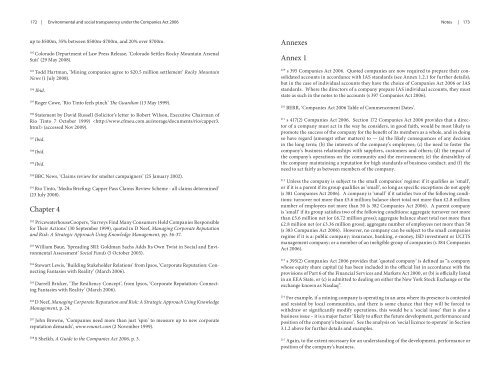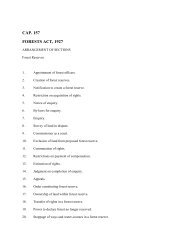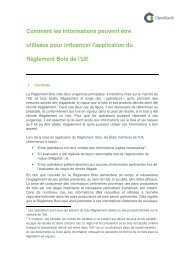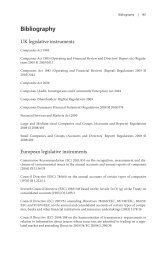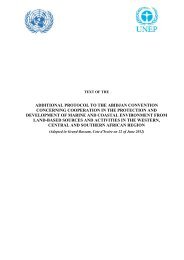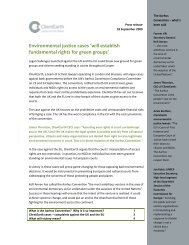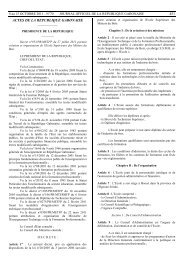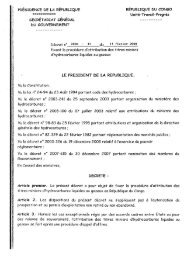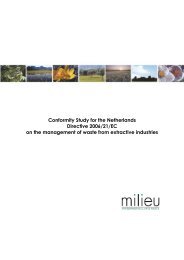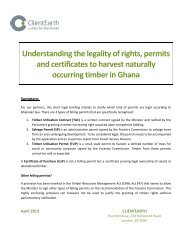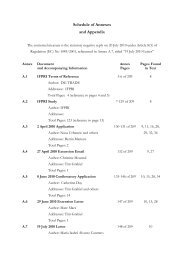Environmental and social transparency under the ... - ClientEarth
Environmental and social transparency under the ... - ClientEarth
Environmental and social transparency under the ... - ClientEarth
- No tags were found...
You also want an ePaper? Increase the reach of your titles
YUMPU automatically turns print PDFs into web optimized ePapers that Google loves.
172 | <strong>Environmental</strong> <strong>and</strong> <strong>social</strong> <strong>transparency</strong> <strong>under</strong> <strong>the</strong> Companies Act 2006Notes | 173up to $500m, 35% between $500m-$700m, <strong>and</strong> 20% over $700m.192Colorado Department of Law Press Release, ‘Colorado Settles Rocky Mountain ArsenalSuit’ (29 May 2008).193Todd Hartman, ‘Mining companies agree to $20.5 million settlement’ Rocky MountainNews (1 July 2008).194Ibid.195Roger Cowe, ‘Rio Tinto feels pinch’ The Guardian (13 May 1999).196Statement by David Russell (Solicitor’s letter to Robert Wilson, Executive Chairman ofRio Tinto 7 October 1999) (accessed Nov 2009).197Ibid.198Ibid.199Ibid.200BBC News, ‘Claims review for smelter campaigners’ (25 January 2002).201Rio Tinto, ‘Media Briefing: Capper Pass Claims Review Scheme - all claims determined’(23 July 2008).Chapter 4202PricewaterhouseCoopers, ‘Surveys Find Many Consumers Hold Companies Responsiblefor Their Actions’ (30 September 1999), quoted in D Neef, Managing Corporate Reputation<strong>and</strong> Risk: A Strategic Approach Using Knowledge Management, pp. 36-37.203William Baue, ‘Spreading SRI: Goldman Sachs Adds Its Own Twist in Social <strong>and</strong> <strong>Environmental</strong>Assessment’ Social Funds (5 October 2005).204Stewart Lewis, ‘Building Stakeholder Relations’ from Ipsos, ‘Corporate Reputation: ConnectingFantasies with Reality’ (March 2006).205Darrell Bricker, ‘The Resiliency Concept’, from Ipsos, ‘Corporate Reputation: ConnectingFantasies with Reality’ (March 2006).206D Neef, Managing Corporate Reputation <strong>and</strong> Risk: A Strategic Approach Using KnowledgeManagement, p. 24.207John Browne, ‘Companies need more than just ‘spin’ to measure up to new corporatereputation dem<strong>and</strong>s’, www.vnunet.com (2 November 1999).208S Sheikh, A Guide to <strong>the</strong> Companies Act 2006, p. 3.AnnexesAnnex 1209s 395 Companies Act 2006. Quoted companies are now required to prepare <strong>the</strong>ir consolidatedaccounts in accordance with IAS st<strong>and</strong>ards (see Annex 1.2.1 for fur<strong>the</strong>r details),but in <strong>the</strong> case of individual accounts <strong>the</strong>y have <strong>the</strong> choice of Companies Act 2006 or IASst<strong>and</strong>ards. Where <strong>the</strong> directors of a company prepare IAS individual accounts, <strong>the</strong>y muststate as such in <strong>the</strong> notes to <strong>the</strong> accounts (s 397 Companies Act 2006).210BERR, ‘Companies Act 2006 Table of Commencement Dates’.211s 417(2) Companies Act 2006. Section 172 Companies Act 2006 provides that a directorof a company must act in <strong>the</strong> way he considers, in good faith, would be most likely topromote <strong>the</strong> success of <strong>the</strong> company for <strong>the</strong> benefit of its members as a whole, <strong>and</strong> in doingso have regard (amongst o<strong>the</strong>r matters) to — (a) <strong>the</strong> likely consequences of any decisionin <strong>the</strong> long term; (b) <strong>the</strong> interests of <strong>the</strong> company’s employees; (c) <strong>the</strong> need to foster <strong>the</strong>company’s business relationships with suppliers, customers <strong>and</strong> o<strong>the</strong>rs; (d) <strong>the</strong> impact of<strong>the</strong> company’s operations on <strong>the</strong> community <strong>and</strong> <strong>the</strong> environment; (e) <strong>the</strong> desirability of<strong>the</strong> company maintaining a reputation for high st<strong>and</strong>ards of business conduct; <strong>and</strong> (f) <strong>the</strong>need to act fairly as between members of <strong>the</strong> company.212Unless <strong>the</strong> company is subject to <strong>the</strong> small companies’ regime: if it qualifies as ‘small’,or if it is a parent if its group qualifies as ‘small’, so long as specific exceptions do not apply(s 381 Companies Act 2006). A company is ‘small’ if it satisfies two of <strong>the</strong> following conditions:turnover not more than £5.6 million; balance sheet total not more than £2.8 million;number of employees not more than 50 (s 382 Companies Act 2006). A parent companyis ‘small’ if its group satisfies two of <strong>the</strong> following conditions: aggregate turnover not morethan £5.6 million net (or £6.72 million gross); aggregate balance sheet total not more than£2.8 million net (or £3.36 million gross); aggregate number of employees not more than 50(s 383 Companies Act 2006). However, no company can be subject to <strong>the</strong> small companiesregime if it is a: public company; insurance, banking, e-money, ISD investment or UCITSmanagement company; or a member of an ineligible group of companies (s 384 CompaniesAct 2006).213s 395(2) Companies Act 2006 provides that ‘quoted company’ is defined as “a companywhose equity share capital (a) has been included in <strong>the</strong> official list in accordance with <strong>the</strong>provisions of Part 6 of <strong>the</strong> Financial Services <strong>and</strong> Markets Act 2000, or (b) is officially listedin an EEA State, or (c) is admitted to dealing on ei<strong>the</strong>r <strong>the</strong> New York Stock Exchange or <strong>the</strong>exchange known as Nasdaq”.214For example, if a mining company is operating in an area where its presence is contested<strong>and</strong> resisted by local communities, <strong>and</strong> <strong>the</strong>re is some chance that <strong>the</strong>y will be forced towithdraw or significantly modify operations, this would be a ‘<strong>social</strong> issue’ that is also abusiness issue – it is a major factor ‘likely to affect <strong>the</strong> future development, performance <strong>and</strong>position of <strong>the</strong> company’s business’. See <strong>the</strong> analysis on ‘<strong>social</strong> licence to operate’ in Section3.1.2 above for fur<strong>the</strong>r details <strong>and</strong> examples.215Again, to <strong>the</strong> extent necessary for an <strong>under</strong>st<strong>and</strong>ing of <strong>the</strong> development, performance orposition of <strong>the</strong> company’s business.


